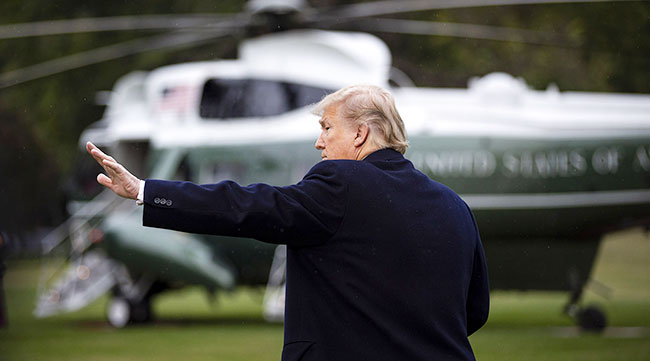Domestic Discretionary Spending Slashed in Trump’s $4.7 Trillion Budget Proposal

President Donald Trump is seeking one of the largest-ever cuts to domestic discretionary spending in a $4.7 trillion fiscal 2020 budget proposal that also boosts defense spending and adds $8.6 billion for building a border wall.
The budget blueprint released March 11, which forecasts annual deficits extending beyond the next decade and rising national debt, represents a wish list for the president’s priorities that is certain to be dismissed by Congress. It also raises the threat of a showdown that could trigger another government shutdown in the fall.
The proposal calls for reducing regular nondefense discretionary spending from $597 billion to $543 billion, a $54 billion, or 9% cut in 2020. When disaster-relief funding is factored in, the cut amounts to $28 billion, or 4.6%.
Particularly hard hit would be the Environmental Protection Agency, and departments of State, Energy, Transportation and Agriculture. EPA would receive a 31% cut compared with its December funding level, while State would receive a 23% cut and Housing and Urban Development would see a 16% cut.
Partial View
The document lacks details on individual programs that normally comes as part of the president’s request. The rest is expected later this month.
The plan provides an early view into the policy platform Trump is likely to adopt in his re-election fight, emphasizing security and immigration control priorities at the expense of welfare programs viewed skeptically by many within his base. But the president also risks providing political fodder for the legion of Democrats seeking to oust him from the White House, who are likely to seize on proposals to cut social services as they seek to persuade suburban voters.

President Donald Trump (Al Drago/Bloomberg News)
Anti-Poverty Programs
The budget’s changes to anti-poverty programs, which are not subject to the budget caps, aren’t likely to pass as long as Democrats control the House. Controversial new eligibility requirements across a range of social service and welfare programs are destined to become an issue in presidential and congressional campaigns in 2020.
To achieve savings among mandatory programs, Medicaid would be transformed partially into a grant program, crop insurance supports would be cut and $200 billion would be saved by changing student loans. The budget says rooting out Medicare waste nets $456 billion over 10 years.
But the president’s top priorities receive a $1 trillion boost over 10 years under his proposal, with additional funding proposed for the construction of his coveted border wall next year, and a $34 billion boost in overall defense spending to $750 billion.
Under current law, the $716 billion defense budget cap would fall to $576 billion in fiscal 2020 and the nondefense cap would fall from $597 billion to $543 billion. Trump is proposing to keep both caps in place while supplying defense with $165 billion in war funds not subject to automatic cuts and another $9 billion in emergency funds.
Pentagon officials and lawmakers have long derided using emergency war funds for regular Defense Department operations a gimmick even as they used it to advance their favorite projects. In the last budget, Trump called for just $73 billion in war funds for the military in 2020.
Even with the cuts and an assumption that the economy would grow at an average 3% for a decade — higher than estimates of private economists — the budget doesn’t balance in 10 years and shows a $202 billion deficit in 2029. The deficit is projected to exceed $1 trillion through 2022. The budget calls for no net tax increases, although some user fees would increase.
Trump’s third budget proposal represents an aggressive opening bid in negotiations with lawmakers, who will be grappling with how to manage automatic budget cuts that under law are scheduled to kick in later this year.
.
President Trump's 2020 #Budget arrives on Capitol Hill. pic.twitter.com/cS1s3ryx6V — CSPAN (@cspan) March 11, 2019
Shutdown Threat
Although Democrats have made clear they will fight wholesale cuts to domestic programs, some of proposals in the budget could be used as money shifts around both in a budget caps deal and eventual spending package.
So far, Democrats say Trump’s heavily partisan proposal risks further damaging an already broken budget process. Disagreements between Trump and Democrats over border-security spending led to a 35-day partial government shutdown that ended earlier this year.
“If they stick to their guns they’ll end up shutting the government down,” said House Budget Committee Chairman John Yarmuth (D-Ky.).
Even with the spending reductions, the budget plan doesn’t claim to lead to a balance for some 15 years. The White House isn’t asking for deep cuts to Medicare and Social Security — or tax increases — that would be necessary to achieve balance within a decade. And even relying on rosy economic projections provided by the White House, the budget projects the nation will cross the mark of $31 trillion in total national debt over the next decade.
Bill Hoagland, a former Republican Senate budget staff director, said the budget isn’t a serious attempt to craft a bipartisan deal that would cut the deficit. During his campaign for president, Trump said he would balance the budget quickly and reduce federal debt.
“The Trump administration has seemingly been overwhelmed by how difficult it is to balance the federal budget while also lowering taxes, preserving mandatory [entitlement] spending and increasing military spending,” he said.
Negotiations over funding caps must be resolved before Congress can pass the 12 annual spending bills needed to keep the government open after Oct. 1.

Anna Moneymaker/Bloomberg News
In each year of his presidency, Trump has proposed slashing domestic agency spending as well some entitlement programs, and in each year Congress has refused. In fact, spending combined with the Republican tax cuts passed last year has increased the federal deficit and put it on course to surpass $1 trillion by 2022, according to the Congressional Budget Office.
The budget request mirrors the one the White House produced last year. Trump in his fiscal 2019 plan called for $3.6 trillion in cuts and this year he is proposing $3.9 trillion in cuts tempered by $1.1 trillion in increases for priorities such as defense and infrastructure.
Last October, the Treasury Department reported that the budget deficit had grown to $779 billion in Trump’s first full fiscal year as president. Amid mounting criticism of his tax overhaul, which had reduced revenues, he said he was proposing a “nickel plan” that would reduce federal spending by 5 cents for every dollar spent.
Trump said at the time that he had had to support higher domestic spending to win Democratic support for military spending increases, and after such “deals with the devil,” agency chiefs should be able to “easily” identify 5% cuts.
The budget plan envisions increases for key priorities of the president, including a wall on the U.S.-Mexico border and infrastructure improvements. As in the past, Trump is proposing $200 billion for infrastructure improvements.
For the wall, Trump is seeking $8.6 billion in addition to the $8 billion he has claimed he can use this year using a combination of congressional appropriations and emergency executive actions.
The next steps in the process toward a budget cap deal will be for the House and Senate budget committees to produce their own budget visions. Senate Budget Chairman Mike Enzi (R-Wyo.) plans to produce a five-year budget vision during the last week of March, while Yarmuth plans to produce a Democratic budget by mid-April. Those budget resolutions could form the basis of a caps deal.
The debate over spending and budget caps also will entangle negotiations on raising the federal debt limit, which snapped back into place March 2. The Treasury Department has been able to shift funds and take other so-called extraordinary measures to prevent a default on the government’s debt.
Many Democrats hope to tie the debt ceiling to a caps accord as a way to speed the process of getting a deal. The true deadline for extraordinary measures to run out is likely by September, while the automatic cuts known as sequestration do not kick in until December or January.
The Trump budget does not explicitly call for a debt ceiling increase but by adding $10 trillion in debt over 10 years, it likely would require many.




